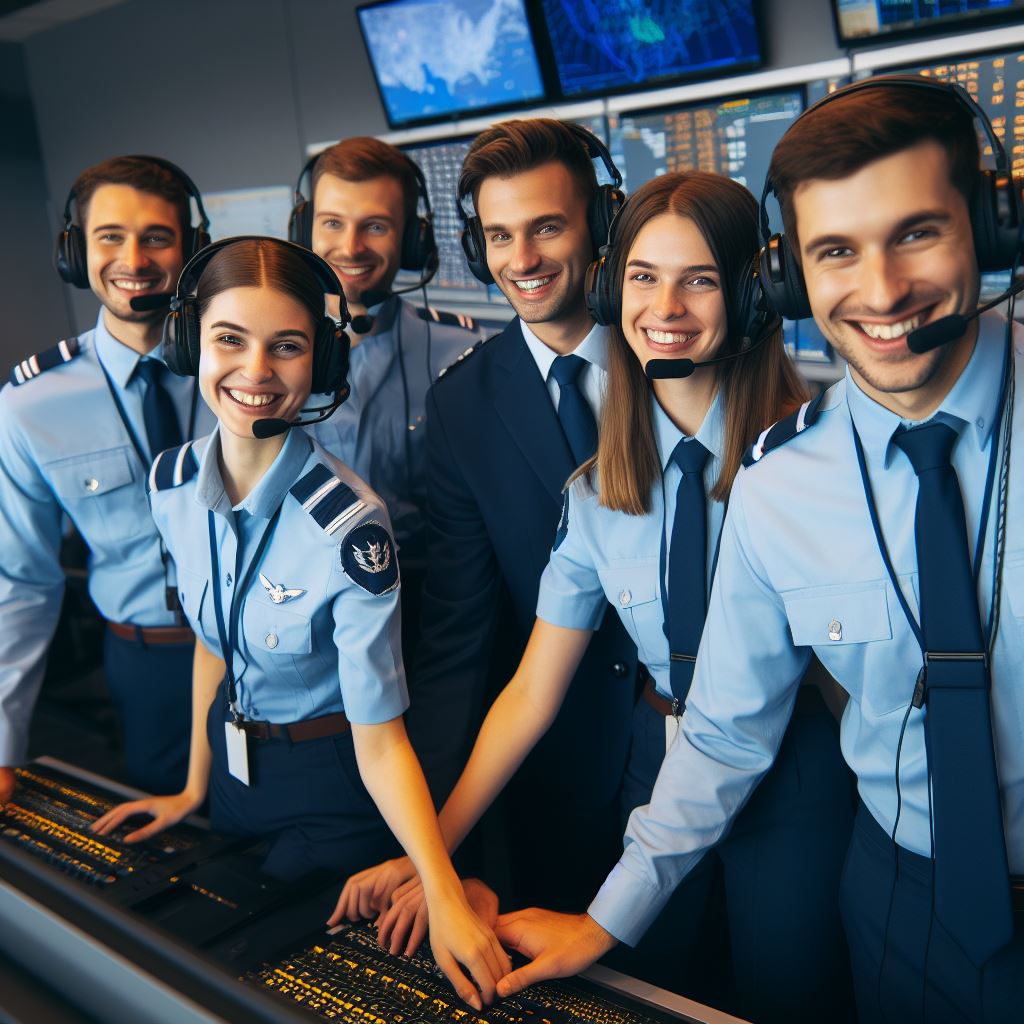Introduction
Being an air traffic controller in the U.S. comes with its own set of challenges and rewards.
Air traffic controllers in the U.S. manage aircraft movements, ensuring safe and efficient airspace operations.
They guide planes, preventing collisions and delays, with precision and constant communication.
This high-stakes profession demands keen attention to detail and quick decision-making, making it a crucial element of the aviation industry.
Aviation professionals face dynamic challenges, from unpredictable weather to complex technology, demanding constant adaptation.
The rewards include unparalleled exhilaration, career variety, and the satisfaction of contributing to a seamless global transportation network.
Despite uncertainties, dedicated individuals find fulfillment in conquering the skies and shaping the future of aviation.
In this blog section, we will explore the unique aspects of this profession and delve into the difficulties and benefits it offers.
Challenges of Being an Air Traffic Controller
- High Level of Stress and Pressure: Air traffic controllers face immense stress and pressure in managing the flow of air traffic. They must make quick decisions while ensuring safety.
- Long and Irregular Working Hours: Air traffic controllers often work in shifts that include evenings, weekends, and holidays. These irregular hours can disrupt their personal lives and lead to sleep deprivation.
- Demanding Mental and Physical Workload: Air traffic controllers need to multitask, analyzing complex data, communicating with pilots, and monitoring radar screens. This mentally and physically demanding workload can be exhausting.
- Responsibility of Ensuring Safety: Air traffic controllers have the crucial responsibility of ensuring the safety of air passengers and pilots. They must remain alert and focused at all times, leaving no room for mistakes.
- Potential for Burnout and Constant Vigilance: The high-pressure environment and demanding workload increase the potential for burnout. Air traffic controllers must maintain constant vigilance to prevent accidents and mitigate risks.
Read: A Day in the Life of a US-based Airline Pilot
Rewards of Being an Air Traffic Controller
Intellectual Satisfaction
- The job of an air traffic controller provides intellectual stimulation and constant mental challenges.
- Analyzing and anticipating air traffic, weather conditions, and other factors offer intellectual satisfaction.
- Controllers use their analytical thinking skills to ensure the safe and efficient flow of air traffic.
Sense of Responsibility and Pride
- Air traffic controllers have a great responsibility in ensuring the safety of thousands of travelers every day.
- They take pride in their ability to maintain safe distances between aircraft and prevent collisions.
- Being entrusted with such critical responsibilities gives controllers a sense of fulfillment and purpose.
Opportunity to Work with Advanced Technologies
- Air traffic controllers work with cutting-edge radar systems, computer displays, and communication technology.
- They embrace the challenge of using advanced tools to manage air traffic efficiently.
- The integration of technology allows controllers to provide precise guidance and ensure safe flight paths.
Potential for Career Growth and Advancement
- Air traffic controllers have various opportunities for career growth, such as becoming supervisory personnel or training instructors.
- With experience, they can specialize in specific sectors, such as approach control or en route control.
- Advancing to management positions or pursuing additional certifications can lead to higher salaries and increased responsibility.
Benefits and Job Security
- Air traffic controllers in the U.S. typically receive excellent benefits, including health insurance and retirement plans.
- The Federal Aviation Administration (FAA) provides job security, making it a stable profession even during economic downturns.
- The demand for air traffic controllers continues to grow, ensuring long-term employment opportunities.
Essentially, being an air traffic controller offers numerous rewards. The intellectual satisfaction derived from analyzing and managing complex air traffic is fulfilling.
The sense of responsibility and pride in ensuring safe air travel brings a deep sense of purpose. Working with advanced technologies allows controllers to stay at the forefront of innovation.
The potential for career growth and advancement provides opportunities for personal and professional development.
Moreover, the job security and benefits associated with this profession make it an attractive choice for those seeking stability and a rewarding career path.
Read: How Technology is Changing the Future of Flying in the US
See Related Content: Career Prospects & Advancement for U.S. Air Traffic Controllers
Training and Education Requirements
When it comes to becoming an air traffic controller, there are specific educational requirements that applicants must meet.
In addition, they have to undergo rigorous training and testing to ensure they are fully prepared for this critical job.
Let’s take a closer look at the educational background needed, the training process, the importance of continuous learning, and the need for obtaining the Air Traffic Control Tower Operator Certificate.
Educational Background
- To become an air traffic controller, a minimum of a high school diploma or equivalent is required.
- However, most applicants possess at least an associate’s or bachelor’s degree in aviation-related fields.
- Having a degree in air traffic management, aviation administration, or a similar discipline is advantageous.
- These educational programs provide students with a solid foundation in aviation principles, regulations, and operations.
Rigorous Training and Testing
- Once applicants meet the educational requirements, they must undergo extensive training.
- This training takes place at the Federal Aviation Administration’s (FAA) Academy in Oklahoma City.
- The training program typically lasts between 2 to 4 months, depending on the specific track chosen.
- During this time, applicants learn about air traffic control procedures, rules, and regulations.
- They also receive hands-on training in simulators to practice real-world scenarios.
- After completing the training, applicants must pass a series of exams and evaluations to demonstrate their competency.
Continuous Learning and Professional Development
- Being an air traffic controller requires a commitment to continuous learning and professional development.
- Controllers must stay current with the latest industry regulations and technological advancements.
- The FAA provides regular updates and training materials to ensure controllers are up to date.
- Air traffic controllers are also required to undergo recurrent training and proficiency checks.
- This ongoing training ensures that controllers maintain their skills and meet the highest standards of safety.
Air Traffic Control Tower Operator Certificate
- Obtaining the Air Traffic Control Tower Operator Certificate is a crucial step in becoming an air traffic controller.
- This certificate is issued by the FAA, and it demonstrates the individual’s knowledge and competence.
- To obtain the certificate, applicants must pass a comprehensive examination.
- The examination covers various topics, including air traffic procedures, regulations, and communication skills.
- Having this certificate not only validates the controller’s abilities but also enhances their career prospects.
- Many employers consider it a mandatory requirement when hiring air traffic controllers.
In essence, becoming an air traffic controller in the U.S. requires a solid educational background, rigorous training, and continuous professional development.
Individuals interested in this career path should consider pursuing aviation-related degrees and meeting the FAA’s educational requirements.
Transform Your Career Today
Unlock a personalized career strategy that drives real results. Get tailored advice and a roadmap designed just for you.
Start NowThe training process at the FAA Academy is intensive, but it ensures that controllers are well-prepared for their demanding role.
Continuous learning is essential in this profession, as regulations and technologies evolve.
Lastly, obtaining the Air Traffic Control Tower Operator Certificate is a definitive step towards a successful career in air traffic control.
Read: Veteran Pilots Share Their Most Memorable Flights

You Might Also Like: The Impact of U.S. Regulations on the Logistician Profession
Work Environment and Support Systems
Being an air traffic controller in the U.S. entails working in a demanding and fast-paced environment.
The typical work environment of an air traffic controller
The work environment of an air traffic controller is unique and demanding.
These professionals work in specialized control towers or en route centers, where they oversee the movement of aircraft in their assigned airspace.
These control rooms are equipped with multiple radar screens and communication devices, allowing controllers to monitor and communicate with pilots effectively.
Collaborative nature of the job and the reliance on teamwork
However, the job of an air traffic controller is not a solitary one. It requires the collaborative effort of a team of controllers and pilots to ensure safe and efficient air travel.
Controllers must work closely with their colleagues to coordinate takeoffs, landings, and the flow of aircraft in the airspace.
These interactions involve clear and concise communication to ensure the smooth operation of flights.
The availability of support systems such as radar and communication technology
Support systems play a crucial role in assisting air traffic controllers in their challenging role.
Radar systems provide controllers with real-time information about aircraft positions, speeds, and altitudes.
This data is crucial for making informed decisions and maintaining proper separation between aircraft.
Advanced communication technology allows controllers to communicate with pilots in their assigned airspace, providing instructions and updates as necessary.
The presence of supervisors and mentors to provide guidance
Supervisors and mentors are also integral to the air traffic control profession.
Experienced supervisors oversee the work of controllers, ensuring compliance with regulations and providing guidance in complex situations.
They are responsible for maintaining safety standards and assisting controllers in handling challenging scenarios effectively.
Recognizing the potential stress associated with being an air traffic controller, support systems also include stress management and counseling services.
Transform Your Career Today
Unlock a personalized career strategy that drives real results. Get tailored advice and a roadmap designed just for you.
Start NowThese services help controllers manage the pressures of the job and mitigate the impact on their mental well-being.
The existence of stress management and counseling services.
Stress management techniques, such as relaxation exercises and time management strategies, are provided to help controllers cope with the demanding nature of their work.
In general, air traffic controllers work in a unique and challenging environment that requires effective coordination, communication, and teamwork.
The availability of advanced radar and communication technology supports their decision-making process, while supervisors and mentors provide guidance to ensure safety and efficiency.
Additionally, stress management and counseling services contribute to the overall well-being of air traffic controllers, enabling them to perform their critical duties effectively.
Read: Transitioning from a Pilot to a Flight Instructor Role
Conclusion
Being an air traffic controller in the U.S. presents both challenges and rewards. Despite the difficulties faced in the profession, it is a career worth considering.
The challenges of being an air traffic controller include high stress levels, long working hours, and the responsibility of ensuring the safety of countless lives in the skies.
The immense pressure and split-second decision-making required can be demanding.
However, the rewards of this profession are equally significant. Air traffic controllers play a crucial role in ensuring safe and efficient air travel.
They have the power to avert potential disasters and save lives through their expertise in managing air traffic flow.
The sense of achievement and pride in being part of a profession that contributes to the safety and smooth functioning of the aviation industry is unparalleled.
The job also offers excellent job security, competitive wages, and opportunities for career advancement.
Despite the challenges, it is important to encourage readers to consider a career as an air traffic controller.
The profession is not for everyone, but for those who have a passion for aviation, problem-solving skills, and the ability to work under pressure, it can be highly rewarding.
The role of air traffic controllers cannot be overstated.
They are the backbone of safe air travel, guiding aircraft and making split-second decisions to ensure the efficient movement of planes.
Without their dedication and expertise, the aviation industry would come to a standstill.
If you have a passion for aviation, a knack for problem-solving, and thrive under pressure, becoming an air traffic controller may be the perfect career choice for you.
Despite the challenges, the rewards and the importance of the profession are truly unparalleled.
Transform Your Career Today
Unlock a personalized career strategy that drives real results. Get tailored advice and a roadmap designed just for you.
Start Now



